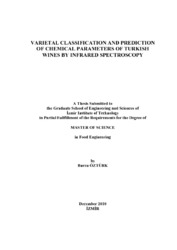Please use this identifier to cite or link to this item:
https://hdl.handle.net/11147/3454Full metadata record
| DC Field | Value | Language |
|---|---|---|
| dc.contributor.advisor | Özen, Fatma Banu | - |
| dc.contributor.author | Öztürk, Burcu | - |
| dc.date.accessioned | 2014-07-22T13:51:33Z | - |
| dc.date.available | 2014-07-22T13:51:33Z | - |
| dc.date.issued | 2010 | - |
| dc.identifier.uri | http://hdl.handle.net/11147/3454 | - |
| dc.description | Thesis (Master)--Izmir Institute of Technology, Food Engineering, Izmir, 2010 | en_US |
| dc.description | Includes bibliographical references (leaves: 57-62) | en_US |
| dc.description | Text in English; Abstract: Turkish and English | en_US |
| dc.description | x, 63 leaves | en_US |
| dc.description.abstract | This study was performed with the aim of varietal classification of mono-varietal Turkish wines and development of models to predict basic enological parameters from mid-IR spectra with the use of chemometric methods. Mid-infrared (MIR) spectroscopy combined with multivariate data analysis was employed to make a varietal classification of commercial Turkish wines (Boğazkere, Cabarnet Sauvignon, Çalkarası, Kalecik Karası, Merlot, Öküzgözü, Papazkarası, Shiraz, Emir, Misket, Narince, Sultaniye and Chardonnay) from 2006 and 2007 vintages. Wine samples (n.79) including red, rose and white wines were scanned in the mid-IR region (4000-650 cm-1) and three spectral regions (965-1565 cm-1, 1700-1900 cm-1 and 2800-3040 cm-1) were used to classify wines on the basis of grape variety. The principal component analysis (PCA) was applied to the spectral data of the wine samples. Although a clear classification could not be achieved according to varieties, almost complete classification of red and white wines was observed. For the quantification analysis, a total of eleven enological parameters, including total phenol and anthocyanin content, pH, brix, titratable acidity, colour intensity (CI), tint, yellow%, red%, blue% and the proportion of red colour produced by anthocyanins (dA%) were determined with analytical reference methods. Correlation between the results of the reference methods and MIR spectral data was tested with partial least square (PLS) regression analysis and prediction models were developed with the use of these correlations. The calibration and validation sets were established to evaluate the predictive ability of the models. As a result of PLS analysis, the best models were developed for total phenols and CI with excellent predictions (R2.0.93 and 0.89, respectively and residual predictive deviation RPD.3.68 and 3.83, respectively). The model of pH determination and yellow% gave a good prediction (R2.0.85 and 0.85, respectively and RPD.2.7 and 2.04, respectively). | en_US |
| dc.language.iso | en | en_US |
| dc.publisher | Izmir Institute of Technology | en_US |
| dc.rights | info:eu-repo/semantics/openAccess | en_US |
| dc.subject.lcsh | Wine and wine making--Turkey | en |
| dc.subject.lcsh | Grapes--Varieties--Turkey | en |
| dc.subject.lcsh | Wine and wine making--Gaging and testing | en |
| dc.subject.lcsh | Wine and wine making--Analysis | en |
| dc.subject.lcsh | Infrared spectroscopy | en |
| dc.title | Varietal Classification and Prediction of Chemical Parameters of Turkish Wines by in Frared Spectroscopy | en_US |
| dc.type | Master Thesis | en_US |
| dc.institutionauthor | Öztürk, Burcu | - |
| dc.department | Thesis (Master)--İzmir Institute of Technology, Food Engineering | en_US |
| dc.relation.publicationcategory | Tez | en_US |
| dc.identifier.wosquality | N/A | - |
| dc.identifier.scopusquality | N/A | - |
| item.openairecristype | http://purl.org/coar/resource_type/c_18cf | - |
| item.languageiso639-1 | en | - |
| item.openairetype | Master Thesis | - |
| item.grantfulltext | open | - |
| item.fulltext | With Fulltext | - |
| item.cerifentitytype | Publications | - |
| Appears in Collections: | Master Degree / Yüksek Lisans Tezleri | |
Files in This Item:
| File | Description | Size | Format | |
|---|---|---|---|---|
| T000866.pdf | MasterThesis | 956.79 kB | Adobe PDF |  View/Open |
CORE Recommender
Page view(s)
206
checked on Mar 31, 2025
Download(s)
80
checked on Mar 31, 2025
Google ScholarTM
Check
Items in GCRIS Repository are protected by copyright, with all rights reserved, unless otherwise indicated.